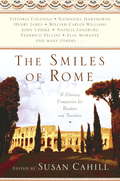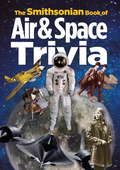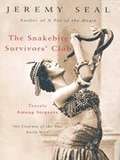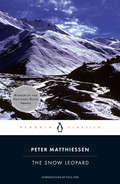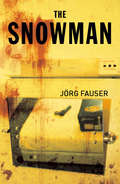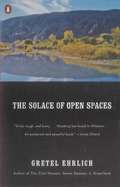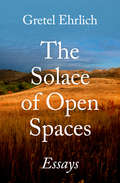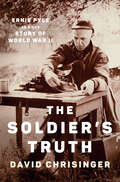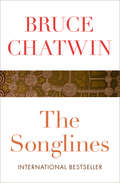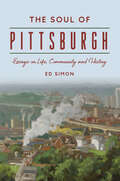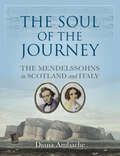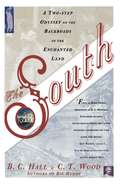- Table View
- List View
The Smiles of Rome
by Susan CahillTake a Roman holiday with some of the world's greatest writersExplore the Palatine with Elizabeth Bowen. Visit the temple of the Vestal Virgins with Georgina Masson. Analyze Michelangelo's Moses with Sigmund Freud. Stroll through ancient streets with Goethe and with Henry James. Share Alice Steinbach's midnight epiphany on a shabby hotel balcony. Learn the art of love from Ovid. Visit villas and gardens with Edith Wharton. Enjoy Rome's myriad moods and pleasures with Robert Browning, Eleanor Clark, Susan Vreeland, and many others.An irresistible collection of writing about one of the world's most beloved destinations, The Smiles of Rome spans the centuries from ancient times to the present day. Each essay resonates with the richness and turmoil of the past and overflows with a great wealth of fascinating facts and intriguing tidbits for today's avid readers and travelers."Rome," writes Susan Cahill, "has the power to blow your mind and heart." This delicious, many-layered collection honoring the city that is the heart and soul of European civilization has the same power to thrill.From the Trade Paperback edition.
The Smithsonian Book of Air & Space Trivia
by Smithsonian InstitutionWho was the first person to dine in space? How long was the Wright brothers's first successful flight? What famous aircraft was named after a grape-flavored soft drink? What toy based on an animated film accompanied astronauts on a shuttle mission in 2000? These questions and many more are answered in The Smithsonian Book of Air & Space Trivia. In addition to the canon of space and aviation information, the pages are illustrated with more than 125 objects from the Smithsonian National Air and Space Museum's collections.
The Smithsonian Institution
by Tamara L. BrittonAn introduction to the history and museums of the Smithsonian Institution in Washington, D.C.
The Smithsonian Institution (Cornerstones of Freedom)
by Mary CollinsDescribes the history of the Smithsonian Institution, its current collections and challenges.
The Snakebite Survivors' Club: Travels Among Serpents
by Jeremy SealTravel writer Seal determined to overcome his phobia about snakes by journeying to America, Australia, Africa, and India in search of some the world's most notorious and deadly snakes and to meet the people who live with them. He found others like him living in constant fear, witch doctors who use snakes as instruments of vengeance, and a case of murder by rattlesnake in the southern US. He also cites scientific facts.
The Snares of Memory
by Juan MarséIn January 1949 on an otherwise unremarkable day in an unremarkable Barcelona neighbourhood cinema, a prostitute is murdered in cold blood in the projection booth by the assistant projectionist, one Fermín Sicart.More than thirty years later, a screenwriter resolves to determine the truth behind her murder, and seeks out Fermin, who has served his time. But though Fermin remembers killing his victim, and exactly how he did it, he cannot for the life of him recall why.The Snares of Memory, by one of the great Spanish men of letters, is at once an investigation of memory, motive and murder and a pointed dig at the Spanish film industry of the second half of the twentieth century.
The Snow Leopard: (penguin Orange Collection) (Picador Bks. #16)
by Peter Matthiessen Pico IyerAn unforgettable spiritual journey through the Himalayas by renowned writer Peter Matthiessen (1927-2014)<P><P> In 1973, Peter Matthiessen and field biologist George Schaller traveled high into the remote mountains of Nepal to study the Himalayan blue sheep and possibly glimpse the rare and beautiful snow leopard. Matthiessen, a student of Zen Buddhism, was also on a spiritual quest to find the Lama of Shey at the ancient shrine on Crystal Mountain. As the climb proceeds, Matthiessen charts his inner path as well as his outer one, with a deepening Buddhist understanding of reality, suffering, impermanence, and beauty. <P> This Penguin Classics edition features an introduction by acclaimed travel writer and novelist Pico Iyer.<P> Winner of the National Book Award
The Snowman
by Anthea Bell Jörg Fauser"Prose that penetrates the reader's mind like speed, fast paced, without an ounce of fat."--WeltwocheHe's found five pounds of top--quality Peruvian cocaine in a suit-case. Pur-sued by the police and drug traffickers the luckless Blum falls prey to the frenzied paranoia of the cocaine addict and dealer. This is a fast-paced thriller written with acerbic humour, a hardboiled evocation of drug-fuelled existence and a penetrating observation of those at the edge of German society.Having broken his addiction to on heroin at the age of thirty, Jörg Fauser spent much of the rest of his life dependent on alcohol. He died aged forty-three in 1987, run over by a truck at four am on a German highway.
The Social Life of Coffee: The Emergence of the British Coffeehouse
by Brian CowanThe Social Life of Coffee refers extensively to early modern source material in various media, printed, manuscript, and visual.
The Social Life of Ink
by Ted BishopA rich and imaginative discovery of how ink has shaped culture and why it is here to stay Ink is so much a part of daily life that we take it for granted, yet its invention was as significant as the wheel. Ink not only recorded culture, it bought political power, divided peoples, and led to murderous rivalries. Ancient letters on a page were revered as divine light, and precious ink recipes were held secret for centuries. And, when it first hit markets not so long ago, the excitement over the disposable ballpoint pen equalled that for a new smartphone--with similar complaints to the manufacturers. Curious about its impact on culture, literature, and the course of history, Ted Bishop sets out to explore the story of ink. From Budapest to Buenos Aires, he traces the lives of the innovators who created the ballpoint pen--revolutionary technology that still requires exact engineering today. Bishop visits a ranch in Utah to meet a master ink-maker who relishes igniting linseed oil to make traditional printers' ink. In China, he learns that ink can be an exquisite object, the subject of poetry, and a means of strengthening (or straining) family bonds. And in the Middle East, he sees the world's oldest Qur'an, stained with the blood of the caliph who was assassinated while reading it. An inquisitive and personal tour around the world, The Social Life of Ink asks us to look more closely at something we see so often that we don't see it at all.
The Socrates Express: In Search of Life Lessons from Dead Philosophers
by Eric WeinerThe New York Times bestselling author of The Geography of Bliss embarks on a rollicking intellectual journey, following in the footsteps of history&’s greatest thinkers and showing us how each—from Epicurus to Gandhi, Thoreau to Beauvoir—offers practical and spiritual lessons for today&’s unsettled times.We turn to philosophy for the same reasons we travel: to see the world from a different perspective, to unearth hidden beauty, and to find new ways of being. We want to learn how to embrace wonder. Face regrets. Sustain hope. Eric Weiner combines his twin passions for philosophy and travel in a globe-trotting pilgrimage that uncovers surprising life lessons from great thinkers around the world, from Rousseau to Nietzsche, Confucius to Simone Weil. Traveling by train (the most thoughtful mode of transport), he journeys thousands of miles, making stops in Athens, Delhi, Wyoming, Coney Island, Frankfurt, and points in between to reconnect with philosophy&’s original purpose: teaching us how to lead wiser, more meaningful lives. From Socrates and ancient Athens to Beauvoir and 20th-century Paris, Weiner&’s chosen philosophers and places provide important practical and spiritual lessons as we navigate today&’s chaotic times. In a &“delightful&” odyssey that &“will take you places intellectually and humorously&” (San Francisco Book Review), Weiner invites us to voyage alongside him on his life-changing pursuit of wisdom and discovery as he attempts to find answers to our most vital questions. The Socrates Express is &“full of valuable lessons…a fun, sharp book that draws readers in with its apparent simplicity and bubble-gum philosophy approach and gradually pulls them in deeper and deeper&” (NPR).
The Solace of Open Spaces
by Gretel EhrlichA stunning collection of personal observations that uses images of the American West to probe larger concerns in lyrical, evocative prose that is a true celebration of the region.
The Solace of Open Spaces: Essays
by Gretel EhrlichThese transcendent, lyrical essays on the West announced Gretel Ehrlich as a major American writer—&“Wyoming has found its Whitman&” (Annie Dillard). Poet and filmmaker Gretel Ehrlich went to Wyoming in 1975 to make the first in a series of documentaries when her partner died. Ehrlich stayed on and found she couldn&’t leave. The Solace of Open Spaces is a chronicle of her first years on &“the planet of Wyoming,&” a personal journey into a place, a feeling, and a way of life. Ehrlich captures both the otherworldly beauty and cruelty of the natural forces—the harsh wind, bitter cold, and swiftly changing seasons—in the remote reaches of the American West. She brings depth, tenderness, and humor to her portraits of the peculiar souls who also call it home: hermits and ranchers, rodeo cowboys and schoolteachers, dreamers and realists. Together, these essays form an evocative and vibrant tribute to the life Ehrlich chose and the geography she loves. Originally written as journal entries addressed to a friend, The Solace of Open Spaces is raw, meditative, electrifying, and uncommonly wise. In prose &“as expansive as a Wyoming vista, as charged as a bolt of prairie lightning,&” Ehrlich explores the magical interplay between our interior lives and the world around us (Newsday).
The Solar System: Discover the mysteries of our sun and neighboring planets (Space Explorers)
by Sophie AllanDiscover our expansive solar system in this breathtaking journey into space. This charming book is the perfect introduction for young readers who want to learn about our local star - the Sun - and the planets that orbit it. The Solar System covers space in thrilling detail and is the perfect book for space lovers everywhere. Packed with mind-blowing facts, this incredible book of the solar system is perfect for space lovers everywhere. This fascinating guide introduces 7-9 year-olds to the birth of the Sun and the solar system, then continues on a journey through space. They discover the smallest planet, rocky Mercury, which is closest to the Sun, and Venus, the hottest planet. There is also Mars, with its polar ice caps and volcanoes, and Jupiter, with its swirling storm clouds. Then readers venture further into space to explore the icy giants of outer space. This wonderful solar system book offers:- In-depth information, backed up by space photography, probe images, illustrations, and fun diagrams.- Striking illustrations, making this title a perfect gift, as well as a solid reference book. - Easy-to-digest sections, each filled with incredible facts and visuals.STEM learning, with key topics for 7-9 year-olds: labeled images of each of the planets, clear step-by-step visuals to show the birth of our solar system, accessible facts about space missions.Boasting beautiful illustrations by artist Dawn Cooper, combined with up-to-date images from space agencies such as NASA and ESA, info panels, timelines, and diagrams, that help demystify and explain the spectacles of space, this is the ideal book for budding astronauts.At DK, we believe in the power of discovery.So why stop there?If you like The Solar System, then why not complete the collection? Take a trip into space and discover the mysteries of Earth&’s closest neighbor with The Moon. <P><P><i>Advisory: Bookshare has learned that this book offers only partial accessibility. We have kept it in the collection because it is useful for some of our members. Benetech is actively working on projects to improve accessibility issues such as these.</i>
The Soldier's Truth: Ernie Pyle and the Story of World War II
by David ChrisingerA beautiful reckoning with the life and work of the legendary journalist Ernie Pyle, who gave World War II a human face for millions of Americans even as he wrestled with his own demonsAt the height of his fame and influence during World War II, Ernie Pyle&’s nationally syndicated dispatches from combat zones shaped America&’s understanding of what the war felt like to ordinary soldiers, as no writer&’s work had before or has since. From North Africa to Sicily, from the beaches of Anzio to the beaches of Normandy, and on to the war in the Pacific, where he would meet his end, Ernie Pyle had a genius for connecting with his beloved dogfaced grunts. A humble man, himself plagued by melancholy and tortured by marriage to a partner whose mental health struggles were much more acute than his own, Pyle was in touch with suffering in a way that left an indelible mark on his readers. While never defeatist, his stories left no doubt as to the heavy weight of the burden soldiers carried. He wrote about post-traumatic stress long before that was a diagnosis.In The Soldier's Truth, acclaimed writer David Chrisinger brings Pyle&’s journey to vivid life in all its heroism and pathos. Drawing on access to all of Pyle&’s personal correspondence, his book captures every dramatic turn of Pyle&’s war with sensory immediacy and a powerful feel for both the outer and the inner landscape. With a background in helping veterans and other survivors of trauma come to terms with their experiences through storytelling, Chrisinger brings enormous reservoirs of empathy and insight to bear on Pyle&’s trials. Woven in and out of his chronicle is the golden thread of his own travels across these same landscapes, many of them still battle-scarred, searching for the landmarks Pyle wrote about.A moving tribute to an ordinary American hero whose impact on the war is still too little understood, and a powerful account of that war&’s impact and how it is remembered, The Soldier's Truth takes its place among the essential contributions to our perception of war and how we make sense of it.
The Someday Birds
by Julie Mclaughlin Sally J. Pla<P>The Someday Birds is a debut middle grade novel perfect for fans of Counting by 7s and Fish in a Tree, filled with humor, heart, and chicken nuggets. <P>Charlie’s perfectly ordinary life has been unraveling ever since his war journalist father was injured in Afghanistan. When his father heads from California to Virginia for medical treatment, Charlie reluctantly travels cross-country with his boy-crazy sister, unruly brothers, and a mysterious new family friend. He decides that if he can spot all the birds that he and his father were hoping to see someday along the way, then everything might just turn out okay. <P>Debut author Sally J. Pla has written a tale that is equal parts madcap road trip, coming-of-age story for an autistic boy who feels he doesn’t understand the world, and an uplifting portrait of a family overcoming a crisis.
The Songlines (Picador Bks.)
by Bruce ChatwinInternational Bestseller: The famed travel writer and author of In Patagonia traverses Australia, exploring Aboriginal culture and song—and humanity&’s origins. Long ago, the creators wandered Australia and sang the landscape into being, naming every rock, tree, and watering hole in the great desert. Those songs were passed down to the Aboriginals, and for centuries they have served not only as a shared heritage but as a living map. Sing the right song, and it can guide you across the desert. Lose the words, and you will die. Into this landscape steps Bruce Chatwin, the greatest travel writer of his generation, who comes to Australia to learn these songs. A born wanderer, whose lust for adventure has carried him to the farthest reaches of the globe, Chatwin is entranced by the cultural heritage of the Aboriginals. As he struggles to find the deepest meaning of these ancient, living songs, he is forced to embark on a much more difficult journey—through his own history—to reckon with the nature of language itself. Part travelogue, part memoir, part novel, The Songlines is one of Bruce Chatwin&’s final—and most ambitious—works. From the author of the bestselling In Patagonia and On the Black Hill, a sweeping exploration of a landscape, a people, and one man&’s history, it is the sort of book that changes the reader forever. This ebook features an illustrated biography of Bruce Chatwin including rare images and never-before-seen documents from the author&’s estate.
The Sordid Secrets of Las Vegas
by Paula Munier Quentin ParkerWhether this is your first or fiftieth visit, you'd be surprised at how much of the city's mystique you can miss while you're pulling slots until dawn. From getting comped at a casino every time to finding the best stripper to teach you how to pole dance, you'll learn all of the hidden magic that permeates this incredible city in this tell-all handbook. You'll also get an insider's take on:How to get invited to the Fetish and Fantasy BallWhy you shouldn't drink the water in VegasWhere to have a $5,000 lunch Where to find the world's biggest topless poolWho's been blacklisted by the Gaming Control BoardOrganized according to the seven deadly sins, the hidden gems in this book are your key to uncovering the dirty secrets of Sin City!
The Sorrow of Angels
by Jón Kalman StefánssonIt is three weeks since the boy came to town, carrying a book of poetry to return to the old sea captain - the poetry that did for his friend Bárður. Three weeks, but already Bárður's ghost has faded. Snow falls so heavily that it binds heaven and earth together. As the villagers gather in the inn to drink schnapps and coffee while the boy reads to them from Shakespeare's Hamlet, Jens the postman stumbles in half dead, having almost frozen to his horse. On his next journey to the wide open fjords he is accompanied by the boy, and both must risk their lives for each other, and for an unusual item of mail. The Sorrow of Angels is a timeless literary masterpiece; in extraordinarily powerful language it brings the struggle between man and nature tangibly to life. It is the second novel in Stefánsson's epic and elemental trilogy, though all can be read independently.
The Sorrow of Angels
by Jón Kalman StefánssonIt is three weeks since the boy came to town, carrying a book of poetry to return to the old sea captain - the poetry that did for his friend Bárður. Three weeks, but already Bárður's ghost has faded. Snow falls so heavily that it binds heaven and earth together. As the villagers gather in the inn to drink schnapps and coffee while the boy reads to them from Shakespeare's Hamlet, Jens the postman stumbles in half dead, having almost frozen to his horse. On his next journey to the wide open fjords he is accompanied by the boy, and both must risk their lives for each other, and for an unusual item of mail. The Sorrow of Angels is a timeless literary masterpiece; in extraordinarily powerful language it brings the struggle between man and nature tangibly to life. It is the second novel in Stefánsson's epic and elemental trilogy, though all can be read independently.
The Soul of Pittsburgh: Essays on Life, Community and History (The History Press)
by Ed Simon"Europe stretches to the Alleghenies, America lies beyond." - Ralph Waldo Emerson "They are my people and this is my town and it does my heart good just to be here." - Art Rooney Sr. What does it mean to be from Pittsburgh? Author Ed Simon explores the nature of the Yinzer and how the Steel City shapes anyone who is fortunate to call it home.
The Soul of the Journey: The Mendelssohns in Scotland and Italy
by Diana AmbacheBrother and sister Felix and Fanny Mendelssohn enjoyed a rare bond: they were intimate companions and theirs was one of the most significant musical relationships of the 19th century. They shared and commented on each other’s compositions, each highly appreciative of the other but also offering frank, critical advice. Their travels produced some great music – Felix’s best loved works, the Hebrides Overture and the Scottish Symphony, were inspired by his 1829 visit to Scotland, whilst Fanny’s innovative piano cycle Das Jahr was a musical response to the tour of Italy she made in 1839–40. Combining letters and sketches with an accompanying narrative describing their journeys, this is a wonderful celebration of the two Mendelssohns and a portrait of Scotland and Italy of the time as seen through the eyes of two of the Romantic movement’s most acclaimed composers.
The Sound of One Hand Killing
by Peter Bush Teresa SolanaThe director of an exclusive New Age meditation centre in a fancy Barcelona neighborhood is murdered, a case for twin detectives Borja and Eduard. The murder of a CIA agent simultaneously drags them into an international conspiracy that transports them to China and back. This hilarious mystery novel is a remorseless satire of those practicing pseudo-science and pseudo-spirituality.
The Sound of Seattle: 101 Songs that Shaped a City
by EVA WALKER Jacob UittiThis rockin' paperback explores the musical evolution of Seattle through the lens of 101 songs spanning 80 years, examining the most prominent and important music and musicians to come out of our corner of the country, with a foreword by Pearl Jam legend Mike McCready.KEXP DJ and musician Eva Walker and music writer Jake Uitti take readers on a musical journey, exploring the songs and artists instrumental to developing the "Seattle sound." The authors have curated the ultimate playlist for the Emerald City. It all begins in 1942 when Washington-born Bing Crosby records what will become the world's bestselling single of all time, "White Christmas." From there, readers will delight in a sensory trip through jazz, rock, punk, riot grrrl, pop, rap, grunge, indie, emo, and more, deepening their knowledge and love of the songs that shaped Seattle, and in the process, each of us.Both a love letter and love song to the city, The Sound of Seattle is a visual guide organized by decade, with seminal songs profiled and paired with inventive design reminiscent of a favorite zine or concert poster. Includes interviews with Seattle legends like Heart's Nancy Wilson, as well as sidebars showcasing musical landmarks throughout the city. How has the Emerald City&’s musical output changed and evolved? What is the connective tissue between Ray Charles, Quincy Jones, and Kenny G? Between Melvins, Sleater-Kinney, and Foo Fighters? Between Sir Mix-a-Lot, Macklemore, and Travis Thompson? We're gonna find out!
The South
by B. C. HallA tour through the history, politics, and culture of the South is complemented by interviews with such figures as William Fulbright, Daisy Bates, Rosa Parks, Jimmy Buffett, and Shelby Foote.
